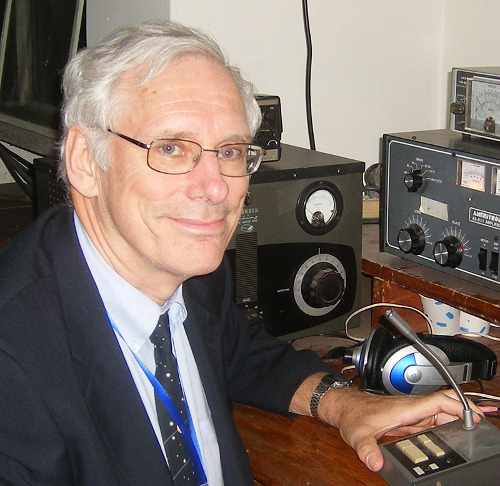 James M. Moran (Photo courtesy of Moran)
James M. Moran (Photo courtesy of Moran)
James M. Moran
Contributed by Kenneth I. Kellermann
The Grote Reber Foundation has announced that Professor Jim Moran will be the recipient of the 2013 Grote Reber Gold Medal. Moran is the Donald H. Menzel Professor of Astrophysics at Harvard University and a Senior Radio Astronomer at the Smithsonian Astrophysical Observatory (SAO), where he has spent his entire career. He also holds a position as Concurrent Professor of Astronomy at Nanjing University and previously served as Chair of the Harvard Department of Astronomy and Associate Director of SAO.
Moran did his undergraduate work at the University of Notre Dame and received his PhD from MIT in 1968. He has previously received the American Astronomical Society’s Newton Lacy Pierce Prize, was the joint recipient of the 1971 Rumford Medal of the American Academy of Arts and Science, and was the 1996 NRAO Jansky Lecturer. He is a member of the US National Academy of Sciences and the American Academy of Arts and Sciences. He is a coauthor of a widely used reference book, Interferometry and Synthesis in Radio Astronomy.
Moran’s interest in radio astronomy began while he was in high school, where he used his experience as an amateur radio operator to build a small radio telescope at 400 MHz to detect the Sun. In 1962, he participated in one of the earliest NRAO summer student programs, which permanently hooked him on radio astronomy as a career.
The Grote Reber Medal is awarded annually for significant and innovative contributions to radio astronomy. Moran is being recognized for his pioneering work in the development and application of spectroscopic Very Long Baseline Interferometry. For his PhD dissertation work, Moran made the first images of maser spots. Later he extended this work to use various molecular masers as tracers of the structure and magnetic fields in the envelopes of late type stars and massive protostars. He continued on to study water vapor, methanol, and silicon monoxide masers in the envelopes of both late-type stars, as well as massive protostars.
Moran also played a key role in the design and application of the NRAO Very Long Baseline Array (VLBA) for spectroscopic observations. In 1994, he led an international group of collaborators and students to use the VLBA to image the masers in the Seyfert galaxy NGC 4258, which convincingly demonstrated that the spots trace an early Keplerian accretion disk around a supermassive black hole. This work provided definitive and direct evidence for the existence of supermassive black holes and the first direct geometric distance estimate to a galaxy independent of the traditional multi-step extragalactic distance ladder.
The VLBA measurement of the distance to NGC 4258 of 7.2±0.5 Mpc was the most precise extragalactic distance measurement at that time, and has played an important role in the calibration of the Cepheid distance scale based on observations of Cepheid variables in NGC 4258. Accurate knowledge of the extragalactic distances is a key factor in establishing the equation of state of dark energy as well as being an essential prerequisite for the determination of the age, energy density, geometry, and evolution of the Universe. Moran was also the director of the Submillimeter Array (SMA) on Mauna Kea during its construction phase. Among other projects, he used the SMA to study the accretion flow in the black hole in the center of our galaxy, Sgr A*.
The 2013 Grote Reber Medal will be awarded to Moran on 8 July 2013 in Turku, Finland, during the European Week of Astronomy and Space Science.
![[IAU logo]](iau_wb_thumb.jpg)
![[URSI logo]](URSI-logo-thumb.jpg)
![[Karl Jansky at his antenna]](jansky_photo_02_thumb.jpg)
![[Reber's Wheaton antenna]](Reber_Telescope_Wheaton_thumb.jpg)
![[Dover Heights]](Dover_Heights_02_thumb.jpg)
![[4C telescope]](GB61-195_4C_telescope_thumb.jpg)
![[Ewen and horn antenna]](ewen_horn1s.jpg)
![[Dwingeloo, 1956]](Dwingeloo-1956-thumb.jpg)
![[Jocelyn Bell Burnell and Cambridge antenna used in pulsar discovery]](burnell2_thumb.jpg)
![[Lovell Telescope at Jodrell Bank]](site_1594_0001-500-334-20180316163019-thumb150.jpg)
![[Wilson, Penzias, and Bell Labs horn antenna]](wilson-penzias-horn_thumb.jpg)
![[6-m Millimeter Radio Telescope in Mitaka, Japan]](6m-thumb.jpg)

